-
Congratulations on winning the Kishida Drama Award. Your winning play,
Our Planet
drew attention for the extremely original style it was created in, and winning this award at the age of 27 is especially young considering the winners in recent years.
While being a member of the directing department of the Seinendan company led by Oriza Hirata , you have led your own company Mamagoto, for which Our Planet was your first production when you presented it in October 2009. Your company’s name is also extremely unique. Can you tell us why you chose it? -
Even if you can’t become a professional painter, anyone can paint or do graffiti. Even if you can’t become a professional singer, we can sing karaoke or hum a tune freely. Yet, even though we can enjoy art and music with familiarity in those ways, I feel that in the case of theater there is greater distance between the people who create theater and the people who watch it and the people who aren’t interested in it to begin with.
But, when you think about it, everyone has “played house” ( mamagoto ) or done some kind of role-playing sometime in their lives, and I thought that can be an entrance to theater. Even if you are not involved in making theater, there can be other types of involvement such as just taking a look at theater and other ways to enjoy it. So, when I chose the name Mamagoto, I wanted to lower the threshold to our theater to that of something more commonplace, as opposed to the kind of polarization you see today between people who are watching or doing theater extremely seriously and people who don’t watch it at all. - I feel like that applies to your theater style as well.
- Yes. The name Mamagoto also applies to the contents of my plays, because I am always thinking up rules each time and approaching it with a bit of playfulness.
- In Our Planet you tried a number of other innovative devices like having a large white circle painted on the stage floor that you had the actors run around and you had them deliver their lines in rap style. You also didn’t limit each actor to one role but had them changing roles again and again. You also used the device of not assigning the actors to fixed roles in your 2009 four-part omnibus of short works Yonshoku no Iroenpitsu ga Areba (If there were four colored pencils…). What is your intention in using that kind of device in your directing?
- Like most people, I had always though that it was common sense for one actor to do one role in a play. So, it was a real shock for me when I read Toshiki Okada ’s Five Days in March and saw the device of roles changing from one actor to another. I realized for the first time that such a thing was possible in theater. Oriza Hirata had also written about that kind of device in his essays about acting theory and directing theory, but t was that encounter with Okada’s play that made me realize that the actor didn’t necessarily have to become one with a given part in a play. It made me realize that a part could be passed on from one actor to the next or that roles could be traded in the midst of a play. And when I started playing with that concept in the studio, it led to a variety of very interesting discoveries.
- When one actor takes on one role, they work to develop that character and that is conveyed to the audience. So, if the roles are changed at will, the way the characters are communicate to the audience becomes completely different, doesn’t it?
-
Yes. For example, the long version of our play
Ayumi
presents the life of one woman acted out by ten actresses. If it were only one actress playing the part, for example if it were played by the actress Miyuki Kurokawa, it would become a case of the character Ayumi brought to life on stage through the actress Miyuki Kurokawa. In our actual play, however, the actress playing the role of Ayumi keeps changing, so the audience has to envision the Ayumi they want to see. Or, in other words, the audience as to use their imaginations to make it one character.
Therefore, I feel that not assigning the role of a character to one actor makes it possible to create a character with some kind of reality [in the mind of the viewer], even though it will not be a specific person. What’s more, if the character that is created in that way fits the imagination of the viewer, it creates a much broader window of approach in that the audience is able to envision the character as they wish. They can project themselves into the character. They can project the image of someone close to them into the character. What I discovered by staging Ayumi in the way was that we were able to create an Ayumi character that anyone could identify with. However, I don’t believe that this device will always be successful each time. - I believe that another unique device you employ in composing your works is having the play proceed through a repetition of the same types of lines or situations.
- I believe that this must be the influence of the hip-hop or techno music that I like to listen to. In these genres, the music of a piece develops through a repetition of the same type of phrase over and over. That inspired me to attempt to see if a play couldn’t be structured or patterned in the same way.
- You used a lot of rap in Our Planet and Yonshoku no Iroenpitsu ga Areba .
-
When I was in university, I liked listening to Japanese hip hop and rap music.
Inherently, hip hop is a genre of music that takes one portion of a song and puts it through a process of “sampling” and “loop” type repetition that creates a new beat and enables the addition of new words to the song. It is a kind of “invention” process that gives birth to a completely different composition or song from the original one.
In other words, it is the product of trial and error in the quest for a method by which people who aren’t musicians, people who can’t read music or play an instrument can still create music. The underlying concept behind that invention is something that really inspired me. Also, it is a basic rule that the rapper writes his or her own words. In short, the rapper and the playwright are both people who use everyday conversational language to express something. And, since rappers also perform or sing their own works, they are like the playwright who is also an actor in and director of his own play. That similarity is very interesting to me.
In rap, there are some songs that are almost purely rhythm and words, and in that sense very close to theater. When I listened to pieces like that it gave me the idea that it might be possible for a playwright to make an approach at rap music. At first, I was just using bits of the rap I like so much in my plays, but with Our Planet I made an attempt to see if I couldn’t create a new kind of music theater, unlike musicals, in which the music and the words were completely separate of each other in terms of composition. - In both Our Planet and in Swing By , which premiered in March this year, you are telling stories of life-sized people but also adding much larger, more universal, framework of time and expansiveness in which to treat the life and death of human beings. As I watched that, Thornton Wilder’s Our Town came to mind, and I felt that you ad created a very new version of Wilder’s work.
-
I am very happy if you felt that way. Wilder has had a very big influence on me, but in fact I didn’t really begin to read Wilder in earnest until after I began doing my own plays. One of the big reasons was that someone who saw
Ayumi
said to me that it was as if watching a new work by Wilder.
I had been interested to read Wilder before that, so I read Our Town and found that here was a playwright that had already been doing the kinds of things I was trying to do. Of course, he had done it in much more skillful methods than me. But, I found that I had a lot in common with Wilder, in the way he created very common characters and portrayed them in ways that anyone could identify with, and also in the way that he didn’t use any specific sets or props and forced the audience to use their imagination to fill in the scenes. Also, the use of a single common person placed in the context of great historical events and large time scale are all there in Our Town and his other works. That discovery started me reading the works of Wilder.
Our Planet began with my idea that if Wilder were writing today, he might write a play juxtaposing a person’s life with a planet rather than a town. Compared to Wilder’s day, you might say that thinking in terms of the Earth as a planet is more familiar to us today. For example, we find out immediately when a war breaks out on the other side of the world today, and we feel the effects of the US on Japan’s economy and, thanks in part to the internet, it has become natural for us to think of things on s global (planet) scale. - I would like to go back now and ask you about when you first got involved in theater. I have heard that your first influence was Koki Mitani.
- Yes. I joined our high school’s theater club thinking that I wanted to do theater, and Koki Mitani was the playwright that I wanted to emulate. So, I was most interested in pursuing situation comedy. I was living in Aichi Pref. (Ichinomiya city) at the time, so I rarely had a chance to see any actual plays. But I was able to watch television dramas and other video performances and read books with commentary about the plays.
- The play Do-Domino that you wrote for a 2003 production by the theater company Baumkuchen when you were at university won the “2nd Sendai Theater Town Drama Award” in 2004. The “Drama Doctor” that instructed the rewriting of the winning script for that production was Oriza Hirata. I saw Do-Domino at that time and found it to be a comedy of chained errors employing a bizarre concept. It used the device of falling dominoes involving thousands of pieces, and in addition to the story line in which a number of human relationships are destroyed in a chain of events, in the end the dominoes actually fall as well. At that time, I found it to be a very well-made work, perhaps with the influence of Koki Mitani.
- I’m impressed that you remembered that (laughs). You are correct. When I came to Tokyo to attend university, I began to see performances of works like Keralino Sandorovich ’s nonsense comedy and situations set like theater of the absurd, and my own writing began to change from around that time.
- After graduating from university you worked for a while at a television production company and then returned to the theater and from 2006 began to write and direct for the company “toi” led by the actress Miyuki Kurokawa.
- At first my intention was to get a job to support myself while continuing to be involved in theater. But the work at the production company was so demanding that I had no time whatsoever for writing plays. So I quit the job after six months (laughs). After quitting my job I did a few short works with Baumkuchen. It was then that I got a request from Kurokawa-san saying that she wanted to do something in the manner of a drama reading.
- After that, in 2007, you joined the directing department of the company Seinendan. How did that come about?
-
After the breakup of Baumkuchen, I didn’t have enough confidence in my methodology or style as a writer to start my own company. But I needed to create a situation where I could do my own works. It was just at that time that I happened to learn about auditions for Seinendan.
From around the time I won the Sendai Award, I had been watching the plays of Seinendan and its linked companies and found them extremely interesting. I also thought they had amazing actors. I used the internet to research Oriza-san’s writings and theories on theater, and that made me decide that I definitely wanted to audition to join the company. So it wasn’t my connection with Oriza-san from the Drama Doctor program but the usual front-door audition route that got me into Seinendan where I am today. - What has been good about being in Seinendan?
- First is being close to people who want to do the same kind of theater as I do. The Seinendan directing department has people who are on the cutting edge of the small-theater scene dong a variety of experimental works, and if I ask them they let me watch their rehearsals, and they will also come to watch mine [and give advice]. Also, Seinendan has outstanding actors, so just being in that environment makes you more serious and intent. What might take you three years to learn on your own can be absorbed a year in that kind of environment. It makes for very full, high-quality time, and that is what I appreciate most valuable about being there. Also, it is very reassuring in my work to know that I can use the Komaba Agora Theater and the rehearsal studios.
- In the last few years a number of talented young people like Shiro Maeda , Shu Matsui and Junnosuke Tada have come out of the Seinendan directing department. Is that because Seinendan is such a good environment for nurturing young talent?
- Rather than the nurturing environment, I think it is that Seinendan gives them a place where they can work productively. By providing a place where it is easy for people who want to do something but lack the space or don’t have enough people around them to work with productively, Seinendan is able to support these people [indirectly]. Whether or not the quality of the works produced improves depends eventually the efforts of the individual. The real value of being at Seinendan I believe is that it provides you with a stimulating working environment and the doors [of opportunity] are always open.
- At toi you did a number of short and longer works. Was it from that time that your writing style began to change?
- When I had Do-Domino rewritten for me [by Oriza Hirata] I was beginning to feel my limitations regarding situation comedy. I began to think that no matter how hard I tried it would be difficult to go beyond what Mitani-san was doing. In 2007, I had the opportunity to participate in the “Geki Oh” (Theater King) event of a series of short plays organized at Nagakute town Bunkano Ie in Aichi Prefecture. For that I decided to try writing in a different style that employed a device of repeated time loops in a one-person play I titled of Hanpuku Katsu Renzoku (repetition and continuation), and that play won the Geki Oh [champion] award.
- In that play Hanpuku Katsu Renzoku , a single actress, with the help of recorded voices, acts out the conversations of a large family.
- When I was writing situation comedies I was struggling to use bizarre situations or characters to create new stories, but with Hanpuku Katsu Renzoku I wanted to try writing in a new way. Instead of the writing style of taking things that nobody knows and writing about them in simple terms as I had done until then, I decided to take a subject that everyone knows and try writing about it from a different perspective.
- In the play Ayumi that we talked about earlier, you used no set at all and had the whole drama develop with women walking constantly in lighting like that of a street light. Here did you get that idea of creating a work based on the act of walking?
- When I thought about why Hanpuku Katsu Renzoku was so well received, I arrived at the idea that in the case of a common act that everyone does, such as getting up in the morning and eating breakfast, we might be seeing this act in repetition. I wrote Ayumi on the idea that people might be able to relate to a work that took an act that everyone is used to experiencing but showed it in a way that is different from the way they are used to seeing it. Most people walk in their daily life, and in the work Ayumi I thought to show that act of walking from a different viewpoint.
- Four of your works, including Hanpuku Katsu Renzoku and Ayumi combine to constitute the omnibus Yonshoku no Iroenpitsu ga Areba . One of the remaining two works, Hyperlin-kun , takes a computer term as its subject. I don’t think there has been any other playwright in Japan to work a play out of computer terminology.
-
I think that may be because that terminology itself has not existed until recently (laughs). Lately, using the internet has become a commonplace in our lives, but the origins of today’s internet is actually the World Wide Web (WWW), isn’t it? It was started on the idea of making all the texts in computers available to be shared and thus give us access to all the knowledge in the world. In other words, it created a condition where all the knowledge in human minds around the world would be connected. Thought that was a fascinating concept.
The scientific and historical development of the human race has always been made possible through the sharing of information in a process of people teaching what they have learned to others. In that sense, it is a natural and commonsense occurrence, but with the advent of the computer, we have been given the opportunity to reconsider and restructure that shared knowledge. Hyperlin-kun was an attempt to explore what phenomenon are taking place through the internet in the medium of actors on a stage. - The fourth work in Iroenpitsu is Junsui Kioku Saiseisochi (Replay device for pure memory), which is performed by four actors acting out stories of meetings and partings of two men and two women, and here again the roles shift between the actors. Furthermore, it involves shifts between the genders with male actors doing female roles at times. The set, in which the whole stage was covered in white paper, was quite beautiful. What was the concept behind this?
- With both Hanpuku Katsu Renzoku and Ayumi I had the feeling that people do not remember things simply as they see them. I felt that our memories of things are actually a multi-faceted mix of perceptions, often containing a mix of very strange images. I began to wonder if I couldn’t put that make-up of memories in the head directly onto the stage in some form. At the same time, I wanted to portray the process of memories being lost. The memories that were clear at first gradually fade as the words become more and more ambiguous, and finally they disappear, literally into pure whiteness. That was part of the reason for the white floor.
- I have heard that you have a notebook that you write down ideas in and use when creating a work. What is it like?
-
I think all writers/directors make notes that they work from, and mine is like a book of graffiti. Things aren’t usually written in sentence form but more often in diagrams. For each of my works there will be one or two of these notebooks. Originally I made an independent study of Hollywood script writing technique when I started writing plays, and I guess that because that influence I work with explanations of scenes and use a method where things are divided up into boxes where there is a conflict and the solution. And, when I was writing situation comedies and beginning to feel a limit to my potential in that genre, I decided to try a different type of diagram. That is how I arrived to my present notebook style.
For example, with Hanpuku Katsu Renzoku , in order to achieve a state where the same story goes on and on, I drew a diagram of arrows with overlaps and directions in an image of one time axis overlapping another. And for the changing of roles between the actors, I made notations like first acting role A and then shifting to A’ and finally shifting from A’ to A’’ in a diagram where it took the form of a single continuous line, and then I transferred that flow into the script. - In terms of the acting method used at Mamagoto, is there an influence of Hirata-san’s methods?
-
Very much so. In terms of the scripts, there are the influences of Mitani-san and Thornton Wilder that I studied on my own, but in terms of what directing involved, I had no idea at first. When I read Oriza-san’s book
Acting and Directing
(
Engi to Enshutsu
) I learned for the first time about a number of things it involves. Still today, the point of origin for most of my methods is clearly Oriza Hirata’s directing method.
For example, concerning the meaning of “dramatic pause,” he taught us that it is a pause to let the audience imagine the developments of the plot, so I will ask for a pause of a certain number of seconds to be inserted at particular points where it is needed. Basically this is the so-called Seinendan directing method. - So, is there a general rule that the lines are to be delivered as you write them and not changed?
- Generally, there is room for the actors to change the lines bit by bit to suit themselves until they have customized lines they are comfortable with. The parts that can be changed are the endings of the sentences and the expressions used, and I have the actors change those freely to suit themselves.
- Until now, plays based on scripts and music theater have been completely separate genre with a different set of actors. But in Our Planet you had contemporary [script] theater actors performing rap. How do you make the rap?
- I thought that there must be a unique kind of rap that could originate from actors as opposed to singers. If there is a rhythm playing but the person doing the rap ignores that beat, it becomes [an actor’s] lines, and if they do it in time with the beat it becomes rap music. If it is a skilled actor, they should be able to negotiate between the two in a mix that defies limitation to either category. If they have the ability to change the pause or quicken it at will, they should be able to go with the rhythm or against it freely. So, we began by having the actors do a workshop to learn about rap and, as I expected, they were very quick to master it.
- Didn’t the actors have any qualms about doing rap?
- For Our Planet we chose a few theme [rap] songs and did a workshop for about a week and most of them were able to master it. As with acting, the individuality of each actor comes out in the performing style. When you make actors who have never done any rap or singing do this kind of training, you find that each actor will perform with their own unique rhythm. These are rhythms that I would never have anticipated, and that’s what is so interesting.
- Is it you that teaches them how to do rap?
- I teach them the basic rules of the rap I have in mind, but after that I leave it up to them. Once they learn to play with the art, they make progress very quickly.
- Compared to rappers from the music world, your actors definitely rap in a way that you can hear the words and they become the lines of actors in a play.
- Yes, they do. And to ensure that they function in the course of the play, I will give director instructions such as, “Make it a bit clearer as lines in the play,” or, “Make it a bit more musical.”
- The way you write the script must be quite different for a “rap musical” like Our Planet .
- It is not as if I have a specific methodology for this. In Our Planet we had eight actors speaking their lines all at once to the same rhythm, so the result was that you lost track of who was saying what at any one point. In order to make it clearer, I borrowed a lot from the writing method of Tengai Amano of Shonen Ohjakan to clarify the timing of rap A would end and rap B would start at the same instant.
- The lines themselves are also different from ordinary conversation.
- The are, because they are written by me as I sang (laughs). I write the rap as rap, keeping to a rhythm and singing as I compose the words.
- In the case of works like Hyperlin-kun , where the lines sound like reading from a dictionary and they are passed from one actor to the next, like surfing from one link to the next on the internet, it seems as if they are composed so that it doesn’t matter which of the actors takes the next line. In fact, how are the lines composed?
- With Hyperlin-kun , I actually had the actors compose their own lines. The order in which the actors would deliver their lines was decided beforehand, and I would tell each actor something like, “At this point, you will talk about this portion of scientific history in rap form.” If I were to write all the rap, we would lose all the benefit of having ten different actors and all of it would end up being in the same rhythm, mine. So, we did a couple of weeks of rap workshops at the beginning and after they became able to compose rap to some degree, I had them write their own rap parts. When they came back with their results and I listened to them, I might say something like, “The words in this part don’t sound good, could you clean them up a bit?” Or, “That’s too straightforward, could you have some expression that is more interesting?” And then, I fit those results together.
- How about with Our Planet ?
- With Our Planet , it was a longer play and I thought it would be OK to unify it all with my own rhythm, so I wrote all of it myself and then put it together like in a musical score. When the actors were given the script I told them which parts were to be done in rap and how I wanted it to be recited or sung. I gave them examples by performing it myself and having them learn it that way.
- With Ayumi was the movement and who would deliver which lines all decided precisely from the start?
- With Ayumi I first wrote a script as a lively conversation between two girls and then in the rehearsal stage I had the actresses walk around and I gradually decided the shifting points and who would deliver which part at which point. If I didn’t actually see them walking on the rehearsal stage, I wouldn’t be able to decide in the writing stage where to have someone stop and deliver her lines. In the 10-actress version and in the three-actress version I divided the parts in that way between the ten or three actresses respectively.
- Watching it, it was hard to know who would speak which part next. Wasn’t it difficult for the actresses to remember?
- I did hear some mumblings about how difficult it was to remember the order and the lines. They said it was hard to keep track of what part they were supposed to be playing, where they were supposed to be at any one time and who they were supposed to be talking to. I did assign then the specific roles and order of delivery and then left it up to them to learn it as we rehearsed [and revised it] in the studio.
- Does that mean that the original text was different from the final play script that you had to work from for the actual performance after the work-up in the rehearsal stage?
- In the cases of Hanpuku Katsu Renzoku and Ayumi , the words themselves did not change. But the assignment of who would speak at what point is something that can be followed physically by watching it but can not be followed in the script, so there is no way to know if it changed or not.
- So, it would be quite difficult to do restaging of the plays some time later, wouldn’t it? In these works [with the shifting of roles] there is no concept of character development, and do the actors remember the movement?
-
Since I had them learning movements that had no relationship to any particular motive and almost no rationale whatsoever, it was quite difficult to learn at first. But when we had a restaging of the production, they seemed to remember most of the movement.
Regarding character development, my belief in these works is rather that a particular actor should not let him/her self fall into any single character role. It is no good if an actor thinks only about his or her own role. In the case of the three-actress Ayumi version, it is structured in a way that each actress has to be watching the other two and thinking about what she has to do next. In other words, they have to have in their minds an image of the entire scene. That is also one of my deliberate aims, to put the actors in that kind of situation. If you can get them to the point where they are able to deliver their lines I that kind constant state of flux and tension, there is no room for them to doing any kind of superfluous “acting.” - Having won the Kishida Drama Award has surely broadened the potential scope of your activities. Will your theater methodology change in the future from what you are doing now?
- Speaking honestly, I don’t feel that there is anything I have established within myself that could be called a methodology. Up until now, I have always been led by the desire to try new things each time and do things that other people haven’t done yet, and it has just been a process of one thing leading to the next without and real direction (laughs). In the course of it all, there might be some hint of a certain quality that runs through my works, or a certain atmosphere to them. It is not the case that I feel it is best not to be bound to any specific methodology, and I would be glad if I were to stumble on something that would make me say, “This is it!” But, on the other hand, I still have the feeling that I want to try a lot of different things.
- What kinds of developments do you see lying in the future for Mamagoto?
-
Mamagoto only consists of myself and a few production people, it has no actors in fact. My working method is to take each work as a starting point from which to move in a slightly new direction each time, and there is no actor who has performed for me through this entire series of works. If my work produces actors who can walk and rap and deliver simultaneous, multi-directional lines, I feel that might open up new horizons and might lead to a fixed methodology.
Calling ourselves a company even though we have no actors was not only an attempt to experiment with new methods but also because I felt that the stimulus from such actors could lead to the next developments, and also because I felt that I was at a stage where I had to think in terms of long-term experiments and accumulating results.
Yukio Shiba
Playing theater like playing house The new approach of Yukio Shiba
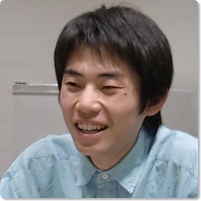
Yukio Shiba
Born in Aichi Pref. in 1982. Shiba is a member of the directing department of the Seinendan theater company. He won the 2nd Sendai Theater Town Playwriting Award for Dodomino , a play written in 2004 while Shiba was a student in the Nihon University’s College of Art. In October 2009 he formed the company “Mamagoto” as an internal “Seinendan Link” company under the Seinendan umbrella. His works for this company are characterized by subtleties of the seemingly unexceptional happenings of everyday life expressed in carefully selected words and then brought to stage with concepts from non-theatrical sources, such as the employment of loops and samplings. Representative works such as Ayumi (Walking), a play in which the actors walk continuously throughout the performance and Hanpuku katsu Renzoku (Repetition and Continuation) in which a mechanism of looped monodrama is employed to portray a large family, are examples of the new perspectives and methods he uses to depict people’s everyday lives. Shiba and his company are also active in regions throughout Japan as exemplified by recent performances and workshops in Aichi Pref., a playwriting seminar in Kani City, Gifu Pref. and directing at the Iwaki Sogo High School in Fukushima Pref., etc. The play Wagahoshi (Our Planet) won the 54th Kishida Kunio Drama Award.
Interviewer: Akihiko Senda
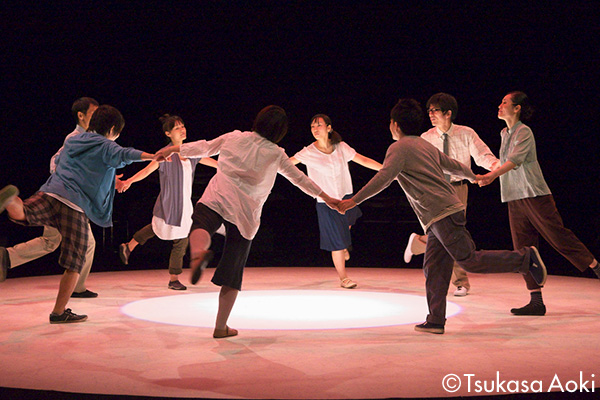
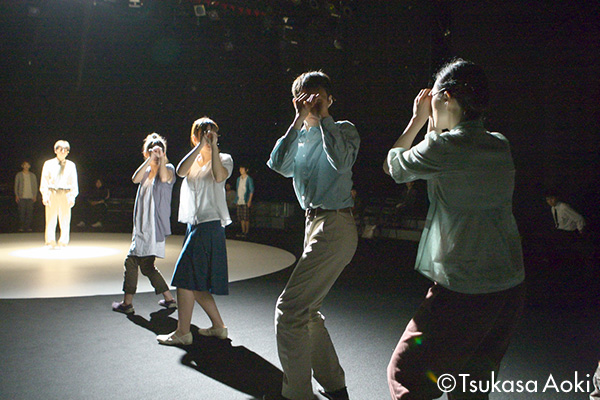
Mamagoto
Wagahoshi
(Our Planet)
(Oct. 8-12, 2009 at Mitaka City Arts Center, Hoshi no Hall)
Photo: Tsukasa Aoki
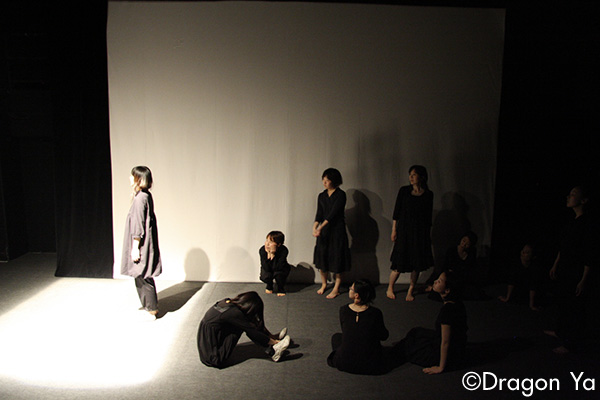
toi presents 3rd
Ayumi
(Jun. 2008 at Komaba Agora Theater)
Photo: Dragon Ya
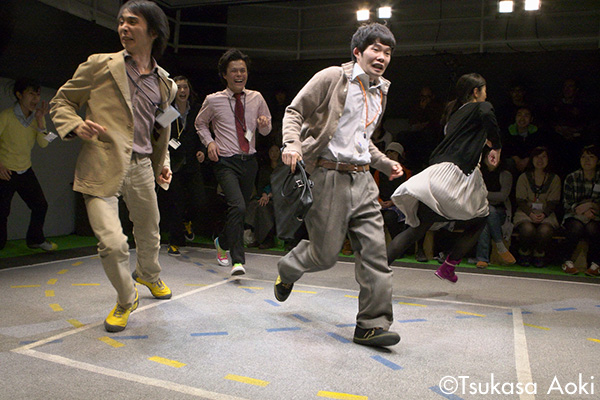
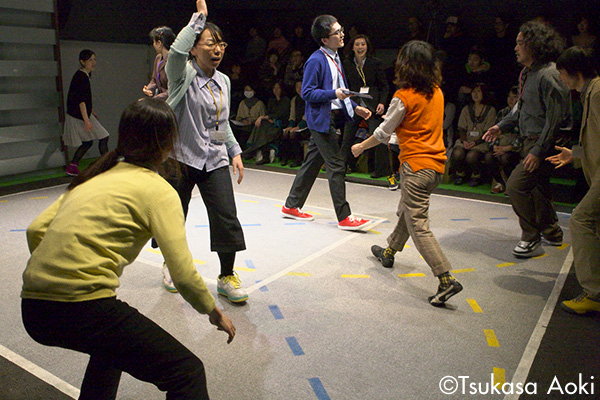
Mamagoto
Swing By
(Mar. 2010 at Komaba Agora Theater)
Photo: Tsukasa Aoki
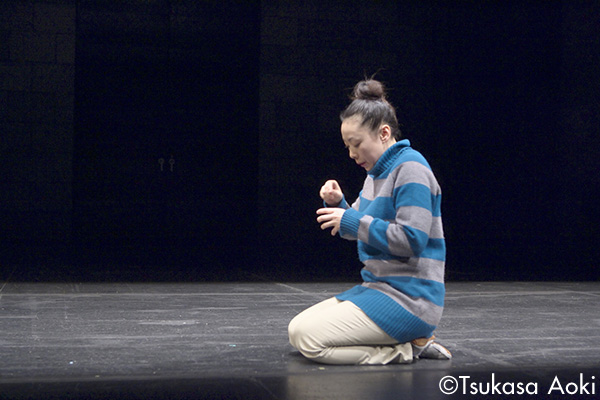
toi 4th production
Yonshoku no Iroenpitsu ga Areba – Hanpuku Katsu Renzoku
(Jan. 2009 at Theatre Tram)
Photo: Tsukasa Aoki
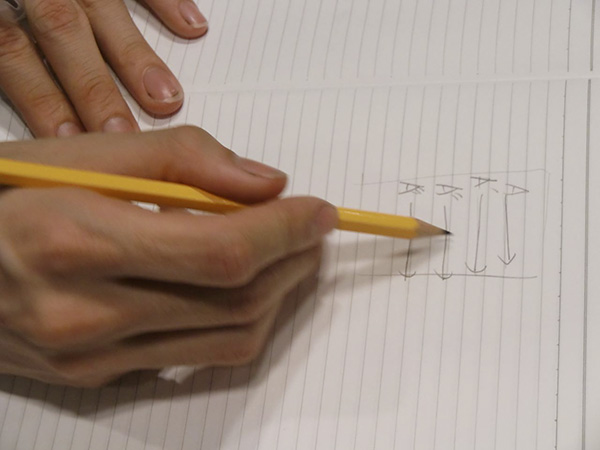
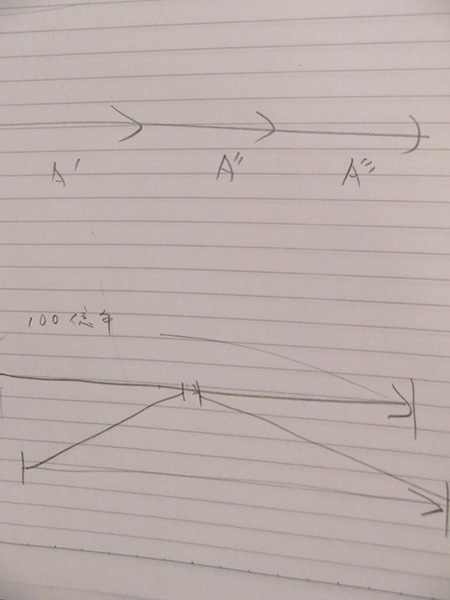
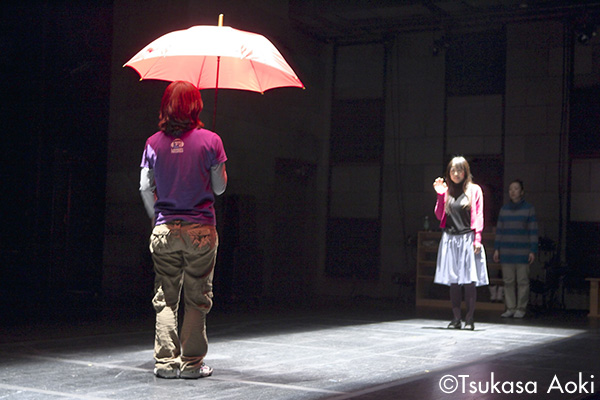
toi 4th production
Yonshoku no Iroenpitsu ga Areba – Ayumi
(short works)
(Jan. 2009 at Theatre Tram)
Photo: Tsukasa Aoki
Related Tags

